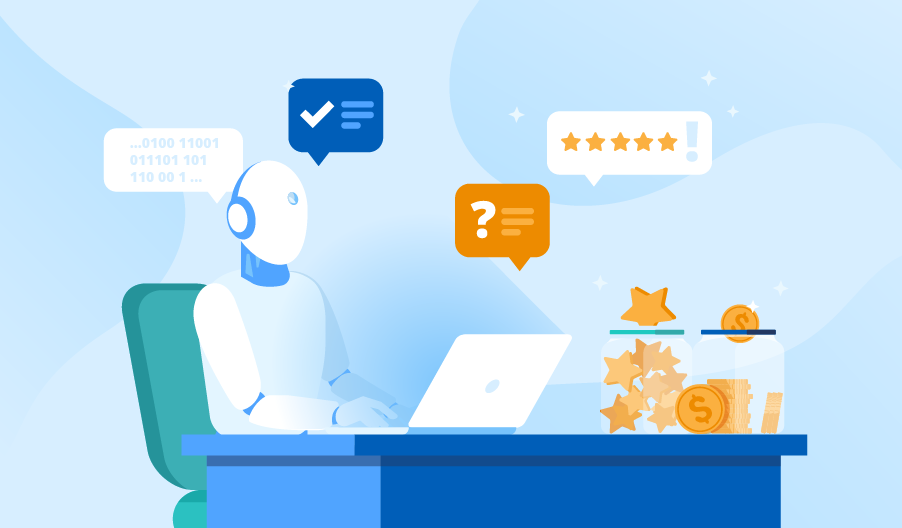Chatbot Development: How to Build and Use Virtual Assistants to Improve Efficiency and Save Money
Editor’s note: Mary talks about the business potential of chatbots as well as the key aspects and complexities behind their implementation and maintenance. And should you be planning to build a custom chatbot solution, ScienceSoft gladly offers assistance with tailored AI application development.
Many medium and large businesses come to ScienceSoft for a solution to manage high volumes of typical queries from their customers or employees. They usually argue that large teams of service agents cost a fortune, while delays or low-quality responses significantly hinder customer satisfaction or employee efficiency. Often, we at ScienceSoft offer them to develop a chatbot as a practical, cost-effective and easy-to-introduce solution of such issues.

What is a chatbot?
A service (business) chatbot receives questions or simple requests in the natural language, reformulates them to make understandable for other software systems, triggers and aggregates the required info from those systems and translates it back to the natural language of a human dialog.
Anton Opimakh, BA at ScienceSoft
Instant messaging (IM) bots can be implemented across different platforms. Usually, users can access them directly from a public site or an intranet page, desktop and mobile messenger services (Telegram, Slack, Skype) or social network platforms (Facebook, Twitter).
You can use an IM bot for:
- Answering repeated general questions.
- Booking tickets/seats/apartments.
- Making appointments.
- Ordering food/goods.
- Supporting, guiding and informing customers/employees.
- Managing employee schedules, and more.
Why are chatbots not everywhere?
Today, we’re still facing a lot of skepticism around chatbots due to their reputation. Chances are you’ve also dealt with those early generations of IM bots. I remember using one of them too. It took me a dozen attempts to pass the request (because I had to enter the exact match of the pre-defined request), and after that, I had to wait for about 10 min to get the answer - either because of high load or the necessity for the chatbot to search through large data sets. So, I understand that it’s hard to believe that chatbots can actually positively influence user experience and bring tangible business value.
Luckily, technology has developed dramatically in recent years, and the capabilities of chatbots have advanced enormously. Now, they can manage impressive loads and have gone far enough in imitating human conversation. Modern chatbots are the programs with powerful AI able to imitate almost natural dialogs and hold long, meaningful conversations. In many contexts, such chatbots can become a significant advantage to the business. Chatbots have proven their ability to positively transform employee experience and improve the efficiency and quality of typical query management, as well as help significantly improve end-user experience, be it customer service or order management.
For example, after the implementation of Ask Julie, Amtrak, an American national railroad operator, has increased the customer engagement rate by 50% and the booking rate by 25%. Ask Julie handles around 50,000 calls per day, resulting in over 20 million interactions per year. On average, Amtrak saves $1 million on customer service yearly.
By embracing a conversational bot to help in completing their car loan applications, Car Loans Canada experienced a 5x conversation increase compared with the traditional landing page conversion.
And we at ScienceSoft witnessed dramatic improvements in our clients’ workflows after IM bot implementation. Some of our clients have managed to cut down the support staff workload by more than 50% and have the number of support tickets declined by 20%
ScienceSoft’s tips for chatbot implementation

Chatbots are created using specific chatbot development platforms, such as Amazon Lex, Azure Bot Service, Dialogflow, and Botpress. The task can be completed by both programmers and non-programmers. What’s the difference? The professional team will ensure more complex functionality through integrations with back-end systems (order management systems, self-service software, billing software, and more).
To develop chatbots that are useful and efficient with minimal risks and at a reasonable cost, we at ScienceSoft adhere to the established approach to chatbot development. And here, I’d like to share its selected elements.
Move iteratively
We recommend going through the chatbot development process in small steps – start with delegating it the simplest tasks and gradually add more sophisticated capabilities continuously monitoring its ROI. Such an arrangement helps save a lot of time and efforts, as well as avoid creating a sophisticated but useless tool.
For example, when we launched the development of our internal vacation chatbot, we didn’t plan its precise scope and capabilities from the start. The reason was in low predictability of how a conversational bot would be perceived by end users and how many tasks could be delegated to it. So, in the first release, we started small. The chatbot had a limited set of intent phrases and was allowed to check the available dates for vacations. After the deployment, we monitored the chatbot’s behavior and collected user feedback. Basing on the received data, in further releases, we empowered users not only to view available dates but also book vacations via chatbot, added new channels to reach the bot and extended the list of its intent phrases. We stopped here as our goals were achieved, but one can go further with more and more complex requests while users are satisfied with the quality, and the chatbot ROI remains high.
Think the architecture through in advance
Even when you start small, it’s vitally important to state appropriate technical requirements for the chatbot architecture. They will enable your chatbot to scale up and fit the extended functionality in the future.
Add deep learning and NLP (natural language processing)
Deep learning and NLP make chatbots self-improving. They understand the essence of the conversation and learn new sentences when talking with a customer. NLP-powered chatbots are capable of maintaining long, sophisticated human-like dialogs. In case of unforeseen situations, they won’t stop but will try to turn the conversation back to the right flow or refer to a live service agent.
With 160 support hours a week and a U.S. median CSR wage of $20.59/h, automating 50% of queries brings about $85,700 in annual labor cost savings. For a typical information-support or scheduling chatbot, implementation starts at around $70,000, with ongoing maintenance from $5,000/month. That means net savings usually turn positive from the second year onward. At 75% automation, yearly savings may reach $128,500 gross, or about $68,500 net after service costs.
Vadim Belski, Head of AI and Principal Architect at ScienceSoft
My other colleague, Alena Madden (Nikuliak), Senior Business Analyst and Healthcare IT Consultant at ScienceSoft, refers to numbers provided by Business Insider Intelligence: up to 73% of customer service in healthcare could be automated using AI-powered chatbots.
Delegate more complex tasks to your chatbot
The most dramatic improvements come with the chatbots that can not only answer general pre-determined questions but also provide info relating to a particular customer (their account, flight, tariff plan, order, payment). For this, a chatbot should be integrated with relevant systems. For example, when our clients have APIs of back-end systems or ESB, we can quickly and safely make the chatbot fetch information from the needed systems. However, often our clients don’t have ones, then we employ robotic process automation (RPA). You can learn the essence of RPA in an article by Andrei Dzimchuk, ScienceSoft’s Senior Solution & Integration Architect.
Let your chatbot act, but keep its power under control
You can make your chatbot perform such complex functions as to book appointments, order food, buy goods, or transfer money, but we recommend wisely balancing low-risk and high-risk tasks. When it comes to payments or sensitive info management, envisage sending a receipt to a customer’s email or a notification to their smartphone or even manual verification from a dedicated agent. Overall, make sure there’s always a possibility of human intervention in case any problems arise.
How to measure a chatbot’s success
The performance and value of chatbots should be visualized to make sure your chatbot really works and is worth it. This will also help you understand whether further improvements are needed. Here’re some of the chatbot metrics we recommend our clients to track:
To assess chatbot maturity:
- User metrics: number of active users, user satisfaction.
- First call goal completion. It's very similar to how a service manager monitors agents.
After the first chatbot version is deployed, we recommend that the chatbot is periodically verified on a sample of dialog queries and additional training is applied to improve it – either in-house or as a part of outsourced support.
- Fallback rate.
To assess business impact:
- Conversion / bounce / leads rate benchmarking.
- Staff workload assessment.
Can I build a chatbot in-house?
Note that your chatbot development project will need professional data scientists to design and train a chatbot and experienced software architects and developers to deal with smooth back-end and third-party systems integrations. If you don’t have relevant experience, competencies and skills in-house, you risk significantly extending project timelines and incurring security issues. Thus, I strongly recommend you to hand over the task to the dedicated vendor. If you feel you need professional support with building an advanced chatbot, my colleagues at ScienceSoft and I will be happy to support your company at any stage of a chatbot development journey, from consulting to implementation and support, just give us a shout.

